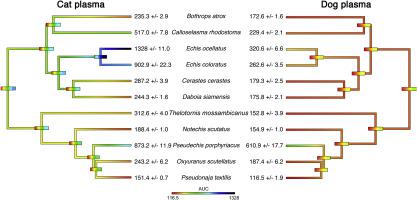当前位置:
X-MOL 学术
›
Comp. Biochem. Physiol. C Toxicol. Pharmacol.
›
论文详情
Our official English website, www.x-mol.net, welcomes your feedback! (Note: you will need to create a separate account there.)
Pets in peril: The relative susceptibility of cats and dogs to procoagulant snake venoms.
Comparative Biochemistry and Physiology C: Toxicology & Pharmacology ( IF 3.9 ) Pub Date : 2020-05-03 , DOI: 10.1016/j.cbpc.2020.108769 Christina N Zdenek 1 , Joshua Llinas 2 , James Dobson 1 , Luke Allen 3 , Nathan Dunstan 3 , Leijiane F Sousa 4 , Ana M Moura da Silva 5 , Bryan G Fry 1
Comparative Biochemistry and Physiology C: Toxicology & Pharmacology ( IF 3.9 ) Pub Date : 2020-05-03 , DOI: 10.1016/j.cbpc.2020.108769 Christina N Zdenek 1 , Joshua Llinas 2 , James Dobson 1 , Luke Allen 3 , Nathan Dunstan 3 , Leijiane F Sousa 4 , Ana M Moura da Silva 5 , Bryan G Fry 1
Affiliation

|
Snakebite is a globally common occurrence for pet cats and dogs, and can be fatal. In Australia the eastern brown snake (Pseudonaja textilis) is responsible for an estimated 76% of reported snakebite cases to domestic pets nationally each year, with the primary pathology being venom-induced consumptive coagulopathy. While only 31% of dogs survive P. textilis bites without antivenom, cats are twice as likely to survive bites (66%). Even with antivenom treatment, cats have a significantly higher survival rate. The reason behind this disparity is unknown. Using a coagulation analyser (Stago STA R Max), we tested the relative procoagulant effects of P. textilis venom-as well as 10 additional procoagulant venoms found around the world-on cat and dog plasma in vitro, as well as on human plasma for comparison. All venoms acted faster upon dog plasma than cat or human, indicating that dogs would likely enter coagulopathic states sooner, and are thus more vulnerable to procoagulant snake venoms. The spontaneous clotting time (recalcified plasma with no venom added) was also dramatically faster in dogs than in cats, suggesting that the naturally faster clotting blood of dogs predisposes them to being more vulnerable to procoagulant snake venoms. This is consistent with clinical records showing more rapid onset of symptoms and lethal effects in dogs than cats. Several behavioural differences between cats and dogs are also highly likely to disproportionately negatively affect prognosis in dogs. Thus, compared to cats, dogs require earlier snakebite first-aid and antivenom to prevent the onset of lethal venom effects.
中文翻译:

危险中的宠物:猫和狗对促凝蛇毒的相对敏感性。
蛇咬伤是宠物猫和狗的全球常见事件,并且可能致命。在澳大利亚,东部棕色蛇(Pseudonaja textilis)每年约占全国全国家养宠物报告蛇咬病例的76%,主要病理是毒液引起的消耗性凝血病。虽然只有31%的狗在没有抗蛇毒杆菌的情况下可以存活于体育假单胞菌叮咬,但猫被叮咬的可能性是其两倍(66%)。即使使用抗蛇毒毒素治疗,猫的存活率也明显更高。这种差异背后的原因尚不清楚。使用凝血分析仪(Stago STA R Max),我们测试了假单胞菌毒液的相对促凝血作用,以及在世界范围内在猫和狗血浆中发现的10种其他促凝血毒液,以及对人血浆的比较。与犬或猫相比,所有毒液对犬血浆的作用都更快,这表明犬可能更早进入凝结性状态,因此更容易受到促凝蛇毒的伤害。狗的自发凝血时间(不添加毒液的重新钙化血浆)也比猫快得多,这表明狗自然更快的凝血速度使它们更容易受到促凝蛇毒的伤害。这与临床记录相吻合,临床记录显示,狗的症状和致死作用比猫更快。猫和狗之间的几种行为差异也极有可能对狗的预后产生不成比例的负面影响。因此,与猫相比,狗需要更早地进行蛇咬急救和抗蛇毒血清,以防止产生致命的毒液。表明狗可能会更早进入凝血病状态,因此更容易受到促凝蛇毒的伤害。狗的自发凝血时间(不添加毒液的重新钙化血浆)也比猫快得多,这表明狗自然更快的凝血速度使它们更容易受到促凝蛇毒的伤害。这与临床记录相吻合,临床记录显示,狗的症状和致死作用比猫更快。猫和狗之间的几种行为差异也极有可能对狗的预后产生不成比例的负面影响。因此,与猫相比,狗需要更早的蛇咬急救和抗蛇毒血清以防止出现致命的毒液。表明狗可能会更早进入凝血病状态,因此更容易受到促凝蛇毒的伤害。狗的自发凝血时间(不添加毒液的重新钙化血浆)也比猫快得多,这表明狗自然更快的凝血速度使它们更容易受到促凝蛇毒的伤害。这与临床记录相吻合,临床记录显示,狗的症状和致死作用比猫更快。猫和狗之间的几种行为差异也极有可能对狗的预后产生不成比例的负面影响。因此,与猫相比,狗需要更早地进行蛇咬急救和抗蛇毒血清,以防止产生致命的毒液。狗的自发凝血时间(不添加毒液的重新钙化血浆)也比猫快得多,这表明狗自然更快的凝血速度使它们更容易受到促凝蛇毒的伤害。这与临床记录相吻合,临床记录显示,狗的症状和致死作用比猫更快。猫和狗之间的几种行为差异也极有可能对狗的预后产生不成比例的负面影响。因此,与猫相比,狗需要更早地进行蛇咬急救和抗蛇毒血清,以防止产生致命的毒液。狗的自发凝血时间(不添加毒液的重新钙化血浆)也比猫快得多,这表明狗自然更快的凝血速度使它们更容易受到促凝蛇毒的伤害。这与临床记录相吻合,临床记录显示,狗的症状和致死作用比猫更快。猫和狗之间的几种行为差异也极有可能对狗的预后产生不成比例的负面影响。因此,与猫相比,狗需要更早地进行蛇咬急救和抗蛇毒血清,以防止产生致命的毒液。这表明狗自然更快的凝血速度使它们更容易受到促凝蛇毒的伤害。这与临床记录相吻合,临床记录显示,狗的症状和致死作用比猫更快。猫和狗之间的几种行为差异也极有可能对狗的预后产生不成比例的负面影响。因此,与猫相比,狗需要更早的蛇咬急救和抗蛇毒血清以防止出现致命的毒液。这表明狗的自然更快的凝血速度使它们更容易受到促凝蛇毒的伤害。这与临床记录相吻合,临床记录显示,狗的症状和致死作用比猫更快。猫和狗之间的几种行为差异也极有可能对狗的预后产生不成比例的负面影响。因此,与猫相比,狗需要更早的蛇咬急救和抗蛇毒血清以防止出现致命的毒液。
更新日期:2020-05-03
中文翻译:

危险中的宠物:猫和狗对促凝蛇毒的相对敏感性。
蛇咬伤是宠物猫和狗的全球常见事件,并且可能致命。在澳大利亚,东部棕色蛇(Pseudonaja textilis)每年约占全国全国家养宠物报告蛇咬病例的76%,主要病理是毒液引起的消耗性凝血病。虽然只有31%的狗在没有抗蛇毒杆菌的情况下可以存活于体育假单胞菌叮咬,但猫被叮咬的可能性是其两倍(66%)。即使使用抗蛇毒毒素治疗,猫的存活率也明显更高。这种差异背后的原因尚不清楚。使用凝血分析仪(Stago STA R Max),我们测试了假单胞菌毒液的相对促凝血作用,以及在世界范围内在猫和狗血浆中发现的10种其他促凝血毒液,以及对人血浆的比较。与犬或猫相比,所有毒液对犬血浆的作用都更快,这表明犬可能更早进入凝结性状态,因此更容易受到促凝蛇毒的伤害。狗的自发凝血时间(不添加毒液的重新钙化血浆)也比猫快得多,这表明狗自然更快的凝血速度使它们更容易受到促凝蛇毒的伤害。这与临床记录相吻合,临床记录显示,狗的症状和致死作用比猫更快。猫和狗之间的几种行为差异也极有可能对狗的预后产生不成比例的负面影响。因此,与猫相比,狗需要更早地进行蛇咬急救和抗蛇毒血清,以防止产生致命的毒液。表明狗可能会更早进入凝血病状态,因此更容易受到促凝蛇毒的伤害。狗的自发凝血时间(不添加毒液的重新钙化血浆)也比猫快得多,这表明狗自然更快的凝血速度使它们更容易受到促凝蛇毒的伤害。这与临床记录相吻合,临床记录显示,狗的症状和致死作用比猫更快。猫和狗之间的几种行为差异也极有可能对狗的预后产生不成比例的负面影响。因此,与猫相比,狗需要更早的蛇咬急救和抗蛇毒血清以防止出现致命的毒液。表明狗可能会更早进入凝血病状态,因此更容易受到促凝蛇毒的伤害。狗的自发凝血时间(不添加毒液的重新钙化血浆)也比猫快得多,这表明狗自然更快的凝血速度使它们更容易受到促凝蛇毒的伤害。这与临床记录相吻合,临床记录显示,狗的症状和致死作用比猫更快。猫和狗之间的几种行为差异也极有可能对狗的预后产生不成比例的负面影响。因此,与猫相比,狗需要更早地进行蛇咬急救和抗蛇毒血清,以防止产生致命的毒液。狗的自发凝血时间(不添加毒液的重新钙化血浆)也比猫快得多,这表明狗自然更快的凝血速度使它们更容易受到促凝蛇毒的伤害。这与临床记录相吻合,临床记录显示,狗的症状和致死作用比猫更快。猫和狗之间的几种行为差异也极有可能对狗的预后产生不成比例的负面影响。因此,与猫相比,狗需要更早地进行蛇咬急救和抗蛇毒血清,以防止产生致命的毒液。狗的自发凝血时间(不添加毒液的重新钙化血浆)也比猫快得多,这表明狗自然更快的凝血速度使它们更容易受到促凝蛇毒的伤害。这与临床记录相吻合,临床记录显示,狗的症状和致死作用比猫更快。猫和狗之间的几种行为差异也极有可能对狗的预后产生不成比例的负面影响。因此,与猫相比,狗需要更早地进行蛇咬急救和抗蛇毒血清,以防止产生致命的毒液。这表明狗自然更快的凝血速度使它们更容易受到促凝蛇毒的伤害。这与临床记录相吻合,临床记录显示,狗的症状和致死作用比猫更快。猫和狗之间的几种行为差异也极有可能对狗的预后产生不成比例的负面影响。因此,与猫相比,狗需要更早的蛇咬急救和抗蛇毒血清以防止出现致命的毒液。这表明狗的自然更快的凝血速度使它们更容易受到促凝蛇毒的伤害。这与临床记录相吻合,临床记录显示,狗的症状和致死作用比猫更快。猫和狗之间的几种行为差异也极有可能对狗的预后产生不成比例的负面影响。因此,与猫相比,狗需要更早的蛇咬急救和抗蛇毒血清以防止出现致命的毒液。



























 京公网安备 11010802027423号
京公网安备 11010802027423号